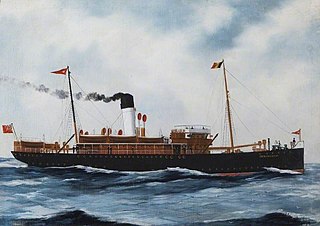 W
WCS Alert, or HMTS Alert, was a cable-laying ship that had a significant role in World War I. She was launched in 1871 for the Submarine Telegraph Company with the name The Lady Carmichael. In 1890 the ship was acquired by the General Post Office (GPO) as part of the nationalisation of the British telegraph network. At the outbreak of World War I, Alert was immediately dispatched to cut German telegraph cables in the English Channel, seriously damaging Germany's ability to securely communicate with the rest of the world. Alert was taken out of service as a cable ship in 1915 but her cable-handling gear was retained for fitting on her replacement. After the war, she worked as a merchant ship under various names, finally being wrecked at Redcar under the name Norham in 1932.
 W
WRMS Asturias was a Royal Mail Steam Packet Company ocean liner that was built in Ireland in 1908 and scrapped in Japan in 1933. She was a Royal Mail Ship until 1914, when on the eve of the First World War the British Admiralty requisitioned her as a hospital ship.
 W
WThe Ayesha was a wooden topsail schooner, which was commandeered by a landing party of the German light cruiser SMS Emden. This landing party was able to escape being taken as prisoners of war, in November 1914, after their ship was destroyed in a battle with the Australian light cruiser HMAS Sydney.
 W
WTrSS Immingham was a passenger and cargo vessel built for the Great Central Railway in 1906.
 W
WThe steamship Kerry Range was a 5,800-ton general cargo freighter, armed with 4.7-inch (119 mm) guns, that had been built by the Northumberland Shipbuilding Company and launched on 27 November 1915. While serving as a Royal Navy armed transport she was damaged in a fire, with loss of life, in Baltimore, Maryland, in October 1917. Investigating officials, after the fire, were convinced the vessel was the target of arson, and that the arsonists were German agents—an enemy of the United Kingdom and the United States, during World War I. Several suspects were arrested. However, it was later determined that the fire on Pier 9, that triggered the fire on board Kerry Range, was due to an electrical malfunction that triggered oakum, a flammable product once used to pack seams on ships. Three crew members lost their lives. Firefighting officials towed the blazing vessel away from the pier, to help prevent it igniting nearby Pier 8, and scuttled her. It took over a day to completely put out the fires on the hulk. Some press reports at the time wrote she was a complete write-off. However, the damaged vessel was salvaged and sold to the Steam Navigation Company of Canada in 1918.
 W
WSS (RMS) Mona's Isle (III), No. 76304, the third ship in the company's history to be so named, was a paddle steamer which served with the Isle of Man Steam Packet Company until she was purchased by The Admiralty in 1915.
 W
WSS River Clyde was a 3,913 GRT British collier built by Russell & Co of Port Glasgow on the Firth of Clyde and completed in March 1905. In the First World War the Admiralty requisitioned her for the Royal Navy and in 1915 she took part in the Gallipoli landings. After the war she was repaired and sold to Spanish owners, with whom she spent a long civilian career trading in the Mediterranean before being scrapped in 1966.
 W
WHMS Seahorse was a Royal Navy fleet tug, tender and survey ship built in 1880. She served until the end of the First World War and was subsequently sold for commercial service in Spain.